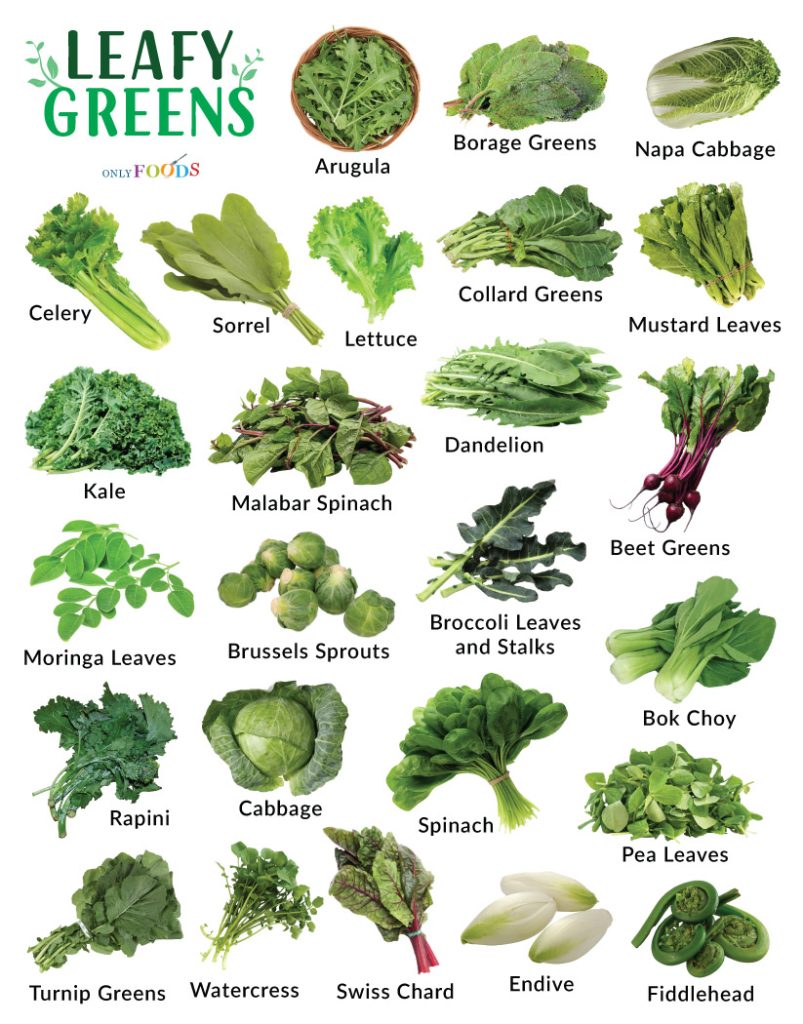Leafy Green Vegetables
Vegetables are edible plant parts, like roots, stems, fruits, and flowers, that form a significant portion of the diet worldwide, regardless of the cuisine. As the name suggests, ‘leafy’ greens are the edible leaves of plants eaten as vegetables. Young shoots and stalks are also included in this description.
Though various types of leafy vegetables come from different plants, their nutritional content and cooking methods are often similar. They are all rich in fibers, vitamins, and minerals like iron, calcium, magnesium, and potassium, while being low in calories. So, they are easily among the healthiest vegetables, with many leafy greens considered ‘superfoods’.
List of the Different Types of Leafy Green Vegetables
- Arugula
- Beet greens
- Bok choy
- Broccoli leaves and stalks
- Brussels Sprouts
- Cabbage
- Celery
- Collard Greens
- Dandelion
- Endive
- Kale
- Lettuce (Romaine, Iceberg, and other varieties)
- Mustard Leaves
- Napa Cabbage
- Pea Sprouts and Leaves
- Radicchio
- Rapini (Broccoli Rabe)
- Spinach
- Swiss Chard
- Watercress
- Paracress
- Grape Leaves
- Moringa Leaves
- Sierra Leone Bologi
- Chili Pepper Leaves
- Sweet Potato Leaves
- Malabar Spinach
- Fat Hen
- Borage Greens
- Pitogo
- Papaya Leaves
- Good King Henry
- Fiddlehead
- Mallow
- Kalette
- Vegetable Hummingbird Leaves
- Komatsuna
- Royal Fern
- Vegetable Fern
- Sorrel
- Land Cress
- Turnip Greens
- Asiatic Pennywort
- Sculpit (Stridolo)
- Leaf Celery
- Chicory
- Chickweed
- Kuka
- Viagra Palm
- Sea Kale
- Summer Purslane
- Atibulnak
- Brooklime
- Garland Chrysanthemum
- Jute Mallow (Melokhia)
- Lagos Bologi
- Catsear
- Lamb’s Lettuce
- Tahitian Spinach
- Sunset Muskmallow
- Red Spinach
- Samphire
- New Zealand Spinach
- Dill
- Arrowhead Elephant Ear
- Cress
- Corn Salad
- Miner’s Lettuce (Winter Purslane)
- Common Purslane
- Celtuce
- Sour Cabbage
- Kerguelen Cabbage
- Water Spinach
- Binung
- Greater Plantain
- Wheatgrass
- Kai-Lan (Gai Lan)
- Golden Samphire
- Chaya
- Tatsoi
- Sea Beet
- Gnetum (Melinjo)
- Fluted Pumpkin Leaves
- Lizard’s Tail
- Spiny Amaranth
- Poke
- Chinese Mallow
- Shepherd’s Purse
- Ground Elder
- Orache
- Mizuna Greens
- Yarrow
- Yao Choy (Yu Choy)
- Lamb’s Quarters
- Taro Leaves
- Soko
- Caraway Leaves
- Purple Bauhinia (Butterfly Tree)
Some leafy greens, like lettuce, arugula, and Chinese cabbage, are commonly eaten raw in salads. Hence, they are often referred to as salad greens.
FAQ
As the name suggests, dark leafy greens have dark green leaves. Examples include spinach, kale, arugula, bok choy, and collard greens. The darker color is often believed to be associated with a higher nutrient content.
These vegetables can be difficult to digest due to the non-soluble fibers present in them. That is why it is recommended to avoid eating them in excess.
Spinach is the most popular leafy green in various smoothie recipes. Other common choices include kale and Swiss chard.
Greens like kale, collard green, and spinach are often added to soups because they don’t take too long to cook and don’t become too soft in the soup.
Collard greens, swiss chard, mustard leaves, and kale are some leafy green vegetables with the largest leaves.

